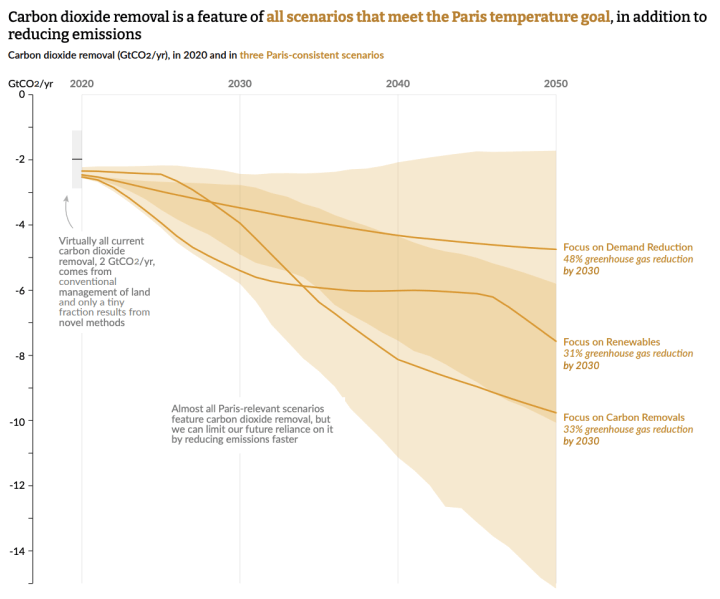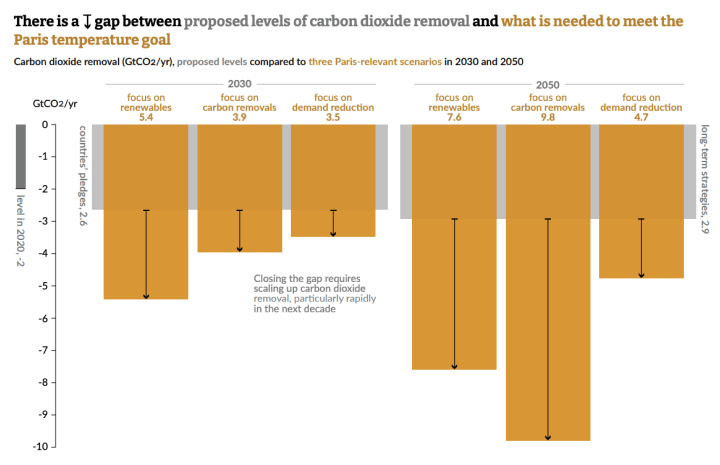

We need to scale up carbon removal. Especially ‘novel’ carbon removal technologies. ASAP.
That’s the main argument of the newly published report ‘The State of Carbon Dioxide Removal’, led by researchers at the University of Oxford’s Smith School of Enterprise and the Environment.
The report finds that there is a fundamental gap in carbon removal: between the amount that scientific models show is needed to meet climate targets, and the reality of expected availability at current levels.
The researchers involved in the report conducted a detailed analysis of the current state of Carbon Dioxide Removal – current availability, and expected future availability based on techniques and projects under development. They also compared this with the models and scenarios which define how much carbon removal we need to achieve in order to stick with our global climate target of keeping warming below 1.5 degrees by 2050.
The main findings are as follows.

1. Novel CDR is needed to meet Paris Agreement climate targets.
- Carbon Dioxide Removal (CDR) is necessary in almost all valid scenarios for meeting the Paris Agreement temperature goal of below 1.5 degrees of warming.
- All of these scenarios include the requirement of a substantial amount of ‘novel CDR’ i.e. new technologies for carbon removal (such as biochar, enhanced weathering, direct air capture). CDR through ‘conventional’ approaches (reforestation, afforestation, improved forest management) will not be able to scale sufficiently to provide the CDR needed to meet climate targets alone.
- There are a few scenarios which meet the Paris Agreement goal without CDR, but they require extremely deep and rapid emissions reductions, which we are way off track to achieve in the time limitations.

2. Currently CDR is lagging far behind what is needed to achieve Paris Agreement climate targets – especially novel CDR approaches.
- Very few countries have published plans to scale their carbon removal above existing levels – which, as we’ve seen, is far behind what is needed.
- In particular, those ‘novel CDR’ approaches make up a tiny amount of existing CDR – just 0.002 Gt of CO2 per year. Most existing CDR is from ‘conventional’ projects, mostly reforestation, afforestation, and improved forest management.
- On average across the scenarios for achieving Paris Agreement climate targets, we need ‘novel CDR’ to increase by a factor of 30 by 2030 and by a factor of 1,300 by 2050.
- The next decade is especially important in the scaling up of CDR, as the amount of CDR we need to see happening from 2050 onwards will only be possible if substantial new deployment is achieved in the next 10 years. So, this decade is ‘novel CDR’s formative phase’, and much rests on its success.
- We need to see new climate policy and ambitious commitments by countries across the world to scale up novel CDR.
To read the full report, go to The State of Carbon Dioxide Removal website.

What does this mean for businesses?
Alongside policymakers, businesses also have an important role in the scale up of novel CDR – as buyers of carbon removal.
Committing to buying carbon removal from early-stage, innovative carbon removal technologies is arguably the most impactful climate action a business can take.
We’ve seen in this report how vital CDR technologies are for reaching climate targets – without novel CDR capacity growing significantly, we simply won’t be able to meet those targets. So, whether it’s to fulfil your net zero target, or simply a commitment to contributing to high-potential carbon removal, we’d encourage all businesses to include carbon removal purchases in their sustainability plans and climate initiatives.
Read more on this topic in our article: Every company should be buying carbon removal today – here's why.
Readers also liked
Readers also liked

Subscribe for emissions intelligence insights
Get the latest updates in the world of carbon tracking, accounting, reporting, and offsetting direct to your inbox.


